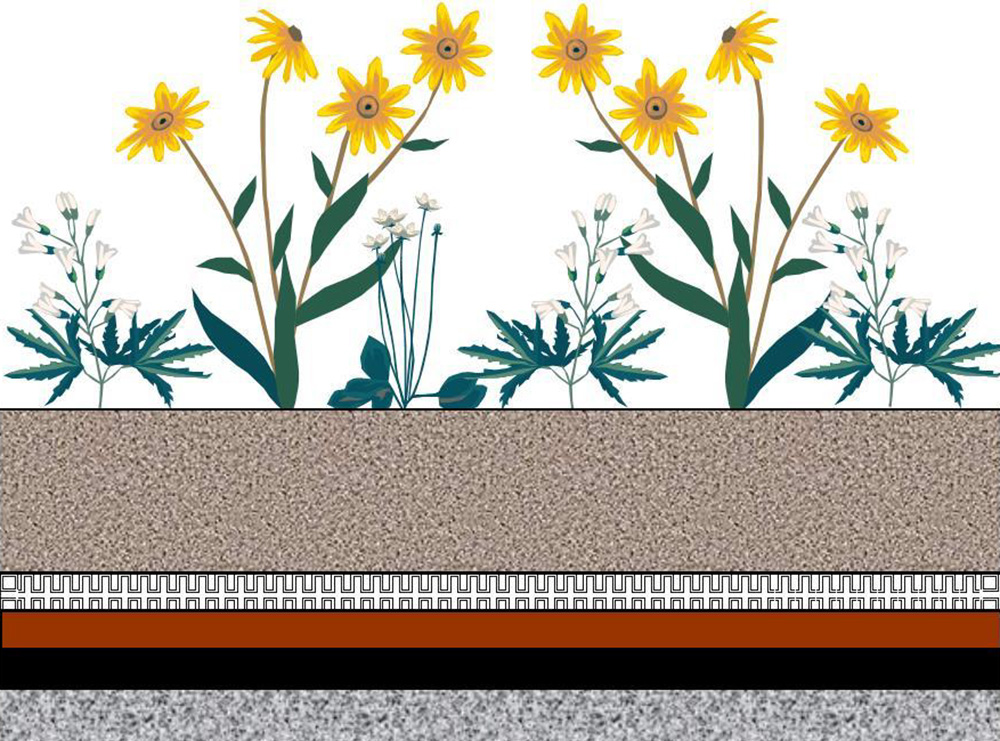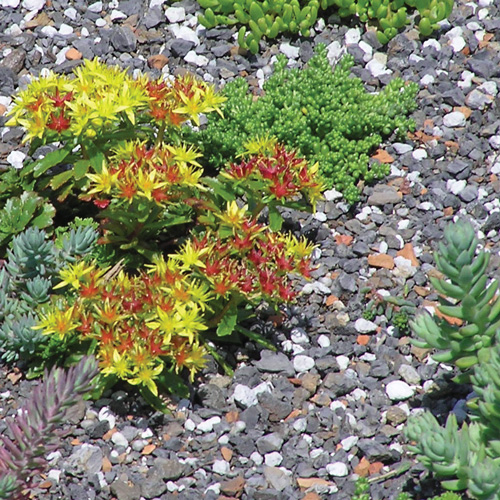 Protecting our environment, one stormwater practice at a time.
Protecting our environment, one stormwater practice at a time.
Vegetated Roofs
Overview
Vegetated roofs (green roofs) are alternative roof surfaces that support plant growth and retain water for plant uptake. Vegetated roofs capture and temporarily store stormwater runoff in the growing media before it is conveyed into the storm drain system. A portion of the captured stormwater is taken up by plants and released into the atmosphere through evapotranspiration. Vegetated roofs create green spaces on top of buildings that help capture rainfall and reduce stormwater runoff.
How Vegetated Roofs Work
 Vegetated roofs are layered systems designed to support plant growth and retain water for plant uptake, while preventing ponding on the roof surface. Vegetated roofs consist of protective membranes, a drainage layer, engineered soil media and a plant layer. The roofs are designed so that water drains vertically through the soil media and then horizontally along a waterproof membrane towards an outlet. Vegetated roofs are classified as extensive or intensive systems based on the depth of the soil media and function of the roof.
Vegetated roofs are layered systems designed to support plant growth and retain water for plant uptake, while preventing ponding on the roof surface. Vegetated roofs consist of protective membranes, a drainage layer, engineered soil media and a plant layer. The roofs are designed so that water drains vertically through the soil media and then horizontally along a waterproof membrane towards an outlet. Vegetated roofs are classified as extensive or intensive systems based on the depth of the soil media and function of the roof.
Cross section illustration of vegetated roof (above) shows, from top to bottom, Plant Layer, Engineered Soil Media, Drainage Layer, Root Barrier Membrane, Waterproofing Membrane, and Structural Support (Roof).
The primary purpose of extensive roof systems is to achieve environmental benefits. Extensive vegetated roofs have a shallow soil media (2 to 6 inches) planted with drought tolerant vegetation such as sedums. They are only accessible for inspection and maintenance, which is minimal after the plants are established.

Intensive roof systems provide environmental benefits as well as accessible green spaces. They generally have a soil media depth of 6 to 12 inches. A greater soil media depth may be used to accommodate a more diverse plant selection that includes small trees or large shrubs. The types of plants used on intensive vegetated roofs may require more maintenance and irrigation than extensive roofs. Intensive roof systems can range from a small public garden to an entire park and are often used on new construction projects. With proper planning and maintenance, these systems can support a variety of wildlife habitat and serve as outdoor educational classrooms.

Extensive vegetated roofs have a low unit weight, low construction cost, low plant diversity and minimal maintenance requirements in comparison with intensive roof systems. These features make extensive vegetated roofs a great option for use on most development and redevelopment sites.
How to Maintain a Vegetated Roof
- Water to promote plant growth and survival as needed
- Weed to remove invasive plants five times per year during the growing season
- Replace any dead or dying vegetation as needed to maintain 90 percent vegetative cover across planted area
- Inspect the waterproof membrane for leaks and cracks annually
- Inspect roof drains, scuppers and gutters twice per year to ensure they are free of blockages and remove any accumulated organic matter or blockages as needed
Vegetated Roofs Suggested Maintenance Timeline
Watering, Replanting: As needed, all year long
Weeding: April, May, July, September, November
Inspect waterproof membrane: Annually
Remove blockages and debris from roof drains, scuppers, and gutters: As needed, all year long

FairFacts
- Vegetated roofs provide an extra layer of insulation to buildings and reduce energy use for heating and cooling.
- Vegetated roofs reduce surface temperatures and protect conventional roofs from damage due to solar radiation.
- Sedums are a succulent plant native to Asia that can survive roof top conditions such as drought and extreme heat by storing water within its leaves.
- Fairfax County maintains five vegetated roofs, including an intensive roof demonstration on the top deck of the Herrity Building parking garage.
The information in this fact sheet is general in nature and is not intended to determine maintenance responsibility.
For more information, contact:
Department of Public Works and Environmental Services, Maintenance and Stormwater Management Division
10635 West Drive, Fairfax, VA 22030
703-877-2800, TTY 711
ContactMSMD@fairfaxcounty.gov

